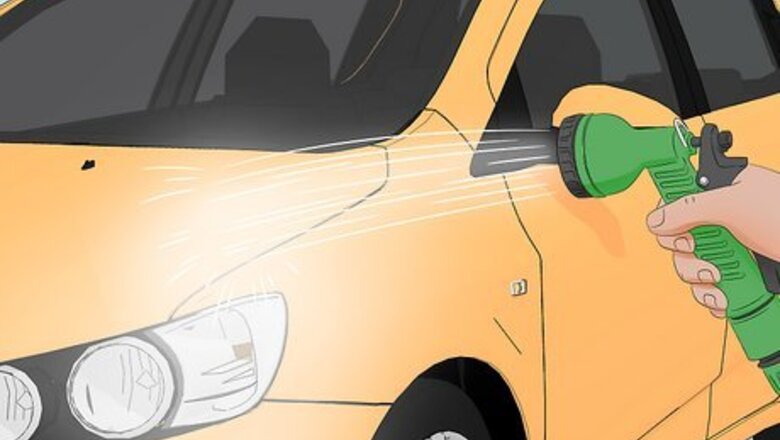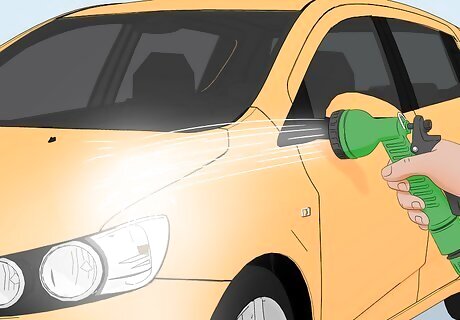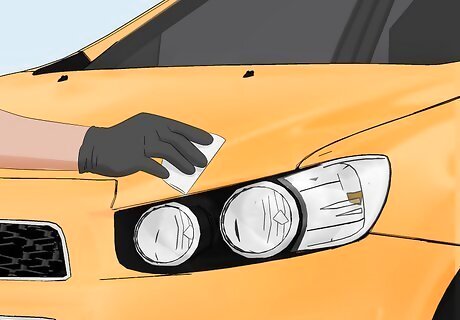
views
- Wash your car thoroughly with a wax-free soap.
- Apply iron remover spray. Wait a few minutes, rinse the spray off, and dry the surface with a microfiber cloth.
- Clay bar the surface to remove contaminants. Then, use medium-duty compound and a dual-action polisher to buff the surface.
- Give your car a final wipe down with a microfibre cloth to remove any lingering residue.
Rinse off your car with plain water.

Hose down your car’s exterior to rinse away loose dirt and debris. Start at the top of your car and slowly work your way to the bottom. Dirt and debris may not seem like a big deal, but if you don't rinse it off first, it may cause micro scratches in your car’s paint job when you go to wash it. Park your car in the shade to wash it to prevent water spots and residue.
Wash your car thoroughly.

Hand-wash your car with a microfiber cloth and a wax-free soap. Fill a bucket with soapy water, dip your microfiber cloth into the solution, and get scrubbing! Work in small sections, starting at the top of your car and working your way to the bottom, rinsing every few minutes so the soap doesn’t create a filmy residue on the surface. Take care to get into all the nooks and crannies—your car needs to be as close to spotless as you can get it. Avoid regular rags and towels since they can scratch the paint. It’s best to hand-wash so you can be meticulous; any debris left on the surface can affect how well the ceramic coating bonds to the surface.
Dry off the vehicle with a microfiber towel.
Towel off the surface to remove moisture and prevent spots. Your car needs to be completely moisture-free before you proceed with the rest of this process, so take the time to give it a thorough drying off. Stick with microfiber cloths since a terrycloth towel could scratch your paint and leave tiny fibers behind.
Apply iron remover and rinse your car again.
An iron remover spray gets rid of contaminants on your car’s surface. Put on disposable gloves and a dust mask before using iron spray. Check your product for specific instructions, but for most iron remover sprays, you simply coat the vehicle’s surface with the spray thoroughly. Wait a few minutes so the spray can penetrate, rinse it off with a water hose, and dry the surface again with a microfiber towel.
Clay bar the surface of the vehicle.

Clay barring eliminates any remaining contamination on your car. Deep cleaning and getting rid of contaminants is extremely important so your ceramic coating lasts. Working in small sections, spray clay bar lubricant on the surface of your car so the clay bar slides over it smoothly. Gently rub the lubricated surface with the clay bar using back-and-forth motions, and wipe the surface clean with a microfiber towel. If the clay bar gets stuck on the surface, just apply a little more lubricant spray. Avoid rubbing in a circular motion since this could scratch your paint job.
Buff the surface with a polishing compound.

Polishing your car removes light scratches and perfects the surface. Use a dual-action polisher to apply compound to the surface of your car, working on one small section at a time. Switch to a clean pad and buff the surface of the car with the polisher using overlapping motions until the compound disappears. A medium-duty compound will get the job done for most cars. If your car is used and has some scratches on it, go with a heavy-duty compound instead. Even if your car is new and you don’t see any visible scratches, go ahead and polish it. Not only will ceramic coating enhance your paint job (which magnifies imperfections), but even light scratches can interfere with bonding.
Wipe down the car with a microfiber cloth.

A final wipe-down ensures your car's surface is pristine. Swipe the microfiber cloth across every panel and visible surface of your car to remove any lingering bits of compound, smudges, and streaks. If you want to be extra thorough, you can wipe the surface down with an IPA spray made for vehicle exteriors, but it's not required. An IPA spray is an isopropyl alcohol solution formulated to remove lingering oils and residue from a vehicle's exterior. Professional detailers often use it ahead of ceramic coating to ensure a strong bond.
Apply the ceramic coating ASAP.

Cars pick up contaminants fast, so do the ceramic coating immediately. The longer you wait after doing the prep work, the more dust and debris will collect on the surface of your car (essentially undoing all of the awesome work you just did). Get your ceramic coating ASAP to ensure the strongest bond and best-looking finish possible.














Comments
0 comment